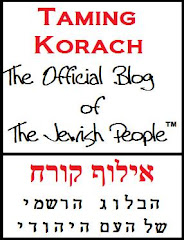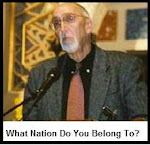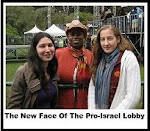Palestine Crusader Diane Mason, in her blog Lawrence of Cyberia, discusses the term Islamofascists in her article that goes by the same name. In the midst of her denouncement of Zionism, Mason, an apparent linguistic expert sometimes cited by Silverstein, makes the following assertion:
Nevertheless, there is a logical gap in this narrative: it’s big enough to drive a bus through it, and it’s called “the Palestinian people”. Zionism has always sold itself – right back to Israel Zangwill’s coining that catchy little phrase, “a land without a people for a people without a land” – by pretending that the Palestinian people aren’t there. Because once you acknowledge that there are already people in Palestine, you have to acknowledge that your Zionist narrative is a very partial truth. Zionism suddenly becomes not just a programme to build a national home for the Jewish people, but a programme to build a national home for the Jewish people in Palestine, which is already home to an indigenous population – 95% of whom (at the time of the first Zionist settlement in 1882) – happen to be non-Jewish. And once you acknowledge that, the issues Zionism raises become suddenly much more complex.Whoa Nelly! Slow down…ever heard of the Old Settlement? Apparently not:
The Old Yishuv (Hebrew: היישוב הישן, ha-Yishuv ha-Yashan) refers to the Jewish community that lived in Eretz Yisrael, from the destruction of the Second Temple in 70 CE to the First Aliyah in 1881, prior to the onset of Zionist immigration. The Old Yishuv dwelled mainly in the Four Holy Cities: Jerusalem, Safed, Tiberias and Hebron.Additionally, the following information, available in in the book Hastening Redemption, shows that the European immigration in 1881 could not have been the first Zionist settlement:
In accordance with the Vilna Gaon’s wishes, three groups of his disciples and their families, numbering over 500, made aliyah to the Land of Israel between 1808 and 1812, a movement documented in Arie Morgenstern’s book, Hastening Redemption. This immigration is considered to be the beginning of the modern settlement of Israel. These groups of ascetics were called Perushim, meaning “separated”, because they separated themselves from worldly pleasures to study the Torah. They originally settled in Safed because the Muslim authorities in Jerusalem prevented settlement by Ashkenazi Jews in that city, but after numerous devastating calamities there, including plague and earthquake, most moved to Jerusalem. Their arrival revived the presence of Ashkenazi Jewry in Jerusalem, which for over 100 years had been mainly Sephardi.Along with the famous 1881 immigration, the was was, in the same year, a separate and simultaneous Yemenite Jewish immigration occurred:
First wave of emigration: 1881 to 1914I happen to know most of Richard Silverstein’s little catch phrases, including the driving a bus through the gap business (he says Mack truck). Looks like Diane Mason has fallen into her own gap-of ignorance.
Emigration from Yemen to Palestine began in 1881 and continued almost without interruption until 1914. It was during this time that about 10% of the Yemenite Jews left. Due to the changes in the Ottoman Empire citizens could move more freely and in 1869 travel was improved with the opening of the Suez Canal, which reduced the travel time from Yemen to Palestine. Certain Yemenite Jews interpreted these changes and the new developments in the “Holy Land” as heavenly signs that the time of redemption was near. By settling in Israel they would be a part in what they believed could precipitate the anticipated messianic era.
From 1881 to 1882 a few hundred Jews left Sanaa and several nearby settlements. This wave was followed by other Jews from central Yemen who continued to move into Palestine until 1914. The majority of these groups moved into Jerusalem and Jaffa. Before World War I there was another wave that began in 1906 and continued until 1914. Hundreds of Yemenite Jews made their way to Palestine and chose to settle in the agricultural settlements. It was after these movements that the World Zionist Organization sent Shmuel Yavne’eli to Yemen to encourage Jews to emigrate to Palestine. Yavne’eli reached Yemen at the beginning of 1911 and returned to Palestine in April 1912. Due to Yavne’eli’s efforts about 1,000 Jews left Yemen left central and southern Yemen with a several hundred more arriving before 1914.















































2 comments:
500 more - 1000 less jews. so what? the aliya before zionism was marginal and in no way political as was zionism. it does not change the overall picture. even in times of the thora non-jews lived in the eretz israel. the jews left and the non jews remained. but for you fascist those people have no rights anyway. so what to do with them? transfere or extermination camps, that's what you and your friends would like. you say yourself: if they don't behave (the way we like it) than they can't be our neighbors. What you talking about? the jordanians, syrians, lebanonies, egyptians and all the others are and will remain our neighbors. unless, of course, you and your harebrained friends will get to power and will show the world what kind of fascists you are.
I never claimed that Jews were a majority under the Ottoman occupation. Your numbers maybe incorrect according to:
http://en.wikipedia.org/wiki/First_Aliyah
The First Aliyah (also The Farmers' Aliyah) was the first modern widespread wave of Zionist aliyah. Jews who migrated to Palestine in this wave came mostly from Eastern Europe and from Yemen. This wave of aliyah began in 1881–82 and lasted until 1903. An estimated 25,000–35,000 Jews immigrated to Ottoman Syria during the First Aliyah. While all throughout history Jews immigrated to Israel (such as the Vilna Gaon's group), these were generally smaller groups with more religious motives, and did not have a purely secular political goal in mind.
Post a Comment